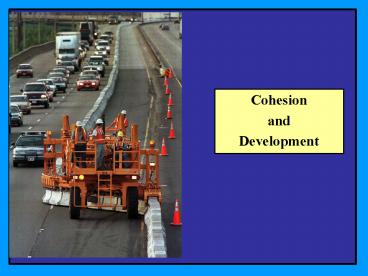Cohesion PowerPoint PPT Presentation
1 / 17
Title: Cohesion
1
- Cohesion
- and
- Development
2
What is group cohesion?
3
- Cohesion Attraction, Liking
Attraction between members
Cohesion
Attraction
Attraction to the group-as-a-whole
4
- Cohesion Unity Cohesive groups stick together
as members cohere to one another and the group - The group is unified solidarity is high in the
group - Members report feeling a sense of belonging to
the group
Group Unity
Cohesion
Unity
Belonging (part of the group)
5
- Cohesion Teamwork Members of cohesive groups
coordinate their efforts to achieve goals - Collective efficacy a high level of confidence
about success at the tasks the group accepts - Esprit de corps positive group affect
Implication Measurement is complex!
Collective Efficacy
Teamwork
Cohesion
Group morale, esprit de corps
Moti- vation
6
Special Issue Hazing
- Hazing, or severe initiations, can increase
members commitment to the group - Festinger, Schachters and Backs classic study
of the Seekers suggested initiations create
dissonance - Aronson and Mills study of severe initiations
- Alternative interpretations and the dangers of
hazing
7
Does Cohesion Develop Over Time?
- Cohesion develops over time in a relatively
predictable pattern - Tuckman's five-stage model of group development
8
Performing
Task
Norming
Storming
Adjourning
Forming
9
Does Cohesion Develop Over Time?
- Types of group development models
- Successive-stage theories Tuckman
- Cyclical models Bales's equilibrium model
- Punctuated equilibrium models periods of
accelerated change
10
What are The Positive and Negative Consequences
of Cohesion?
- Cohesion tends to lead to
- Increased member satisfaction
- Decreased employee turnover and stress
- Cohesive groups can intensify emotional and
social processes. Such groups can - Be more emotionally demanding (e.g, the old
sergeant syndrome) - Exert more conformity pressure on members
- Suffer from groupthink
- Respond with more hostility
11
Cohesion and Performance
12
Road crews
13
Cohesion and Performance
Performance
Cohesion
.25
Norms are also critically important
14
- The cohesion-performance relationship is weakest
if group norms do not encourage high productivity
Groups with norms that stress productivity
P r o d u c t i v i t y
Groups with norms that stress low productivity
15
Should Organizations Rely on Teams to Enhance
Productivity?
- What is a team?
- A specialized, relatively organized, task focused
group - Features (same as any group)
- Interaction
- Interdependence
- Structure
- Goals
- Cohesion
- Types of teams
16
Source Adapted from Devine, 2002.
17
Should Organizations Rely on Teams to Enhance
Productivity?
- Team building
- Setting and clarifying goals and roles
- Designing teams size, communication features,
authority, organization, duration, composition - Practicing (training) orienting, distributing
resources, pacing, coordinating responses, and
motivating members - Process consultation
- Building cohesion by increasing communal
perspective, efficacy - Team approaches are reliably associated with
increases in effectiveness and satisfaction.

